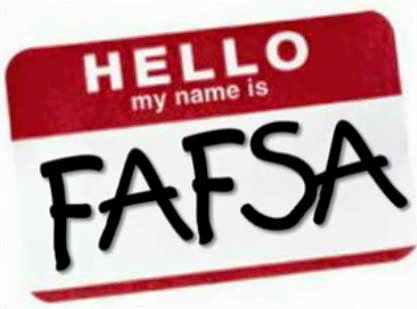If you're a senior, I'm sure you're ready to be done with college applications already. Hold tight, there's a little over one month remaining until the final wave of January deadlines. Revisit your college checklist and make sure to stay focused on getting everything complete with breathing room before the deadline crunch. If you have finished your college applications, good job!
For all seniors, this is the time to start planning for the financial aid process, set to begin when the FAFSA goes live on January 1. Regardless of your family income level you are encouraged to complete the FAFSA (Free Application for Student Aid), found online at www.fafsa.ed.gov. Financial aid is based on need, however with the cost of tuition increasing, many colleges have created policies so that need-based aid can be provided to upper middle-income families in the form of low interest loans that may qualify for forgiveness after graduation from college.
The FAFSA provides colleges with your Expected Family Contribution (EFC), an index that assesses what your family can afford to pay for tuition, room, board, and education-related expenses. As part of the college discovery phase, I look for colleges that try to meet 100% of the family’s need. For example, if upon completing the FAFSA, we learn that your EFC is $15,000, then a competitive financial aid package would show a combination of scholarships, grants, and loans that covers college expenses minus $15,000. In April, we will review more closely how to compare aid packages.
To get started, visit the FAFSA site to create a PIN, one for the student and one for the parent. Keep both PINs in a safe place as you will need for lifetime each time you file a FAFSA for undergraduate, graduate, or professional school education in the United States. Additionally, you will need your 2013 tax information. Contrary to popular belief, there is no need to delay filing your FAFSA until the current year tax forms are completed. Once you have filed 2014 taxes, you can submit a correction to the FAFSA with most updated numbers.
Your EFC will be sent to each college you specify and schools to which you are accepted will use it to calculate your financial aid offer. If you’re curious about either your EFC use this calculator by the College Board. Once you have an EFC, you can visit college’s websites to check their net price, usually found in the financial aid section. This will be good to do so that you can compare costs at different schools.
By starting the financial aid process, you will avoid common pitfalls and get a head start on securing various types of aid available to fund your education before they run out.
For all seniors, this is the time to start planning for the financial aid process, set to begin when the FAFSA goes live on January 1. Regardless of your family income level you are encouraged to complete the FAFSA (Free Application for Student Aid), found online at www.fafsa.ed.gov. Financial aid is based on need, however with the cost of tuition increasing, many colleges have created policies so that need-based aid can be provided to upper middle-income families in the form of low interest loans that may qualify for forgiveness after graduation from college.
The FAFSA provides colleges with your Expected Family Contribution (EFC), an index that assesses what your family can afford to pay for tuition, room, board, and education-related expenses. As part of the college discovery phase, I look for colleges that try to meet 100% of the family’s need. For example, if upon completing the FAFSA, we learn that your EFC is $15,000, then a competitive financial aid package would show a combination of scholarships, grants, and loans that covers college expenses minus $15,000. In April, we will review more closely how to compare aid packages.
To get started, visit the FAFSA site to create a PIN, one for the student and one for the parent. Keep both PINs in a safe place as you will need for lifetime each time you file a FAFSA for undergraduate, graduate, or professional school education in the United States. Additionally, you will need your 2013 tax information. Contrary to popular belief, there is no need to delay filing your FAFSA until the current year tax forms are completed. Once you have filed 2014 taxes, you can submit a correction to the FAFSA with most updated numbers.
Your EFC will be sent to each college you specify and schools to which you are accepted will use it to calculate your financial aid offer. If you’re curious about either your EFC use this calculator by the College Board. Once you have an EFC, you can visit college’s websites to check their net price, usually found in the financial aid section. This will be good to do so that you can compare costs at different schools.
By starting the financial aid process, you will avoid common pitfalls and get a head start on securing various types of aid available to fund your education before they run out.


No comments:
Post a Comment